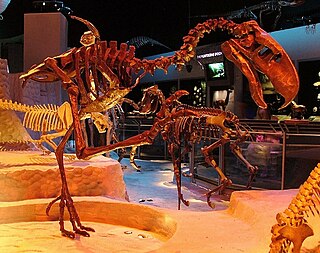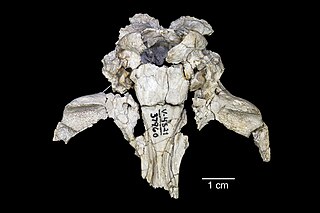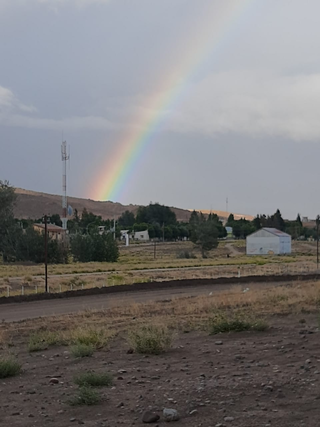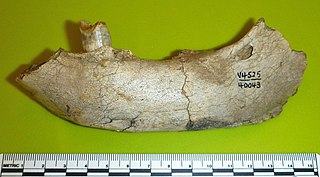
Metatheria is a mammalian clade that includes all mammals more closely related to marsupials than to placentals. First proposed by Thomas Henry Huxley in 1880, it is a more inclusive group than the marsupials; it contains all marsupials as well as many extinct non-marsupial relatives. It is one of two groups placed in the clade Theria alongside Eutheria, which contains the placentals. Remains of metatherians have been found on all of Earths continents.

Phorusrhacids, colloquially known as terror birds, are an extinct family of large carnivorous, mostly flightless birds that were among the largest apex predators in South America during the Cenozoic era. Their definitive fossil records range from the Middle Eocene to the Late Pleistocene around 43 to 0.1 million years ago, though some specimens suggest that they were present since the Early Eocene.

Sparassodonta is an extinct order of carnivorous metatherian mammals native to South America, related to modern marsupials. They were once considered to be true marsupials, but are now thought to be a separate side branch that split before the last common ancestor of all modern marsupials.

Thylacosmilus is an extinct genus of saber-toothed metatherian mammals that inhabited South America from the Late Miocene to Pliocene epochs. Though Thylacosmilus looks similar to the "saber-toothed cats", it was not a felid, like the well-known North American Smilodon, but a sparassodont, a group closely related to marsupials, and only superficially resembled other saber-toothed mammals due to convergent evolution. A 2005 study found that the bite forces of Thylacosmilus and Smilodon were low, which indicates the killing-techniques of saber-toothed animals differed from those of extant species. Remains of Thylacosmilus have been found primarily in Catamarca, Entre Ríos, and La Pampa Provinces in northern Argentina.

Borhyaenidae is an extinct metatherian family of low-slung, heavily built predatory mammals in the order Sparassodonta. Borhyaenids are not true marsupials, but members of a sister taxon, Sparassodonta. Like most metatherians, borhyaenids and other sparassodonts are thought to have had a pouch to carry their offspring around. Borhyaenids had strong and powerful jaws, like those of the unrelated placentalians Hyaenodon and Andrewsarchus, for crushing bones. Borhyaenids grew up to an average of 5 to 6 feet long.

Cramauchenia is an extinct genus of litoptern South American ungulate. Cramauchenia was named by Florentino Ameghino. The name has no literal translation. Instead, it is an anagram of the name of a related genus Macrauchenia. This genus was initially discovered in the Sarmiento Formation in the Chubut Province, in Argentina, and later it was found in the Chichinales Formation in the Río Negro Province and the Cerro Bandera Formation in Neuquén, also in Argentina, in sediments assigned to the SALMA Colhuehuapian, as well as the Agua de la Piedra Formation in Mendoza, in sediments dated to the Deseadan. In 1981 Soria made C. insolita a junior synonym of C. normalis. A specimen of C. normalis was described in 2010 from Cabeza Blanca in the Sarmiento Formation, in sediments assigned to the Deseadan SALMA.
Cyonasua is an extinct genus of procyonid from the Late Miocene to Middle Pleistocene of South America. Fossils of Cyonasua have been found in Argentina, Bolivia, Uruguay, and Venezuela. The oldest well-dated fossils of Cyonasua are approximately 7.3 million years old. Most fossils of Cyonasua are late Miocene to early late Pliocene in age, but a single early Pleistocene specimen indicates that members of this genus survived until at least 0.99 million years ago.

Herpetotheriidae is an extinct family of metatherians, closely related to marsupials. Species of this family are generally reconstructed as terrestrial, and are considered morphologically similar to modern opossums. They are suggested to have been insectivores. Fossils of herpetotheriids come from North America, Asia, Europe, Africa, and perhaps South America. The oldest representative is Maastrichtidelphys from the latest Cretaceous (Maastrichtian) of the Netherlands and the youngest member is Amphiperatherium from the Middle Miocene of Europe. The group has been suggested to be paraphyletic, with an analysis of petrosal anatomy finding that North American Herpetotherium was more closely related to marsupials than the European Peratherium and Amphiperatherium.

Anachlysictis gracilis is an extinct carnivorous mammal belonging to the group Sparassodonta, which were metatherians that inhabited South America during the Cenozoic. Anachlysictis is the first record of such borhyaenoids in northern South America, and also the most primitive known member of the family Thylacosmilidae, a group of predators equipped with "saber teeth". It was also the only confirmed record of a thylacosmilid that did not belong to the genus Thylacosmilus until the official publication of Patagosmilus in 2010.

Dukecynus is an extinct genus of meat-eating metatherian belonging to the order Sparassodonta, which lived in South America during the Middle Miocene (Laventan), between about 13.8 and 11.8 million years ago. The name of the genus meaning "Duke dog", for Duke University and the Greek word cynos, dog, for the pretended similarity of this animal with dogs. A single species known so far, Dukecynus magnus. The species name "magnus" derives from Latin for big, to reflect their great size.

Thylacosmilidae is an extinct family of metatherian predators, related to the modern marsupials, which lived in South America between the Miocene and Pliocene epochs. Like other South American mammalian predators that lived prior to the Great American Biotic Interchange, these animals belonged to the order Sparassodonta, which occupied the ecological niche of many eutherian mammals of the order Carnivora from other continents. The family's most notable feature are the elongated, laterally flattened fangs, which is a remarkable evolutionary convergence with other saber-toothed mammals like Barbourofelis and Smilodon.

Prothylacinus is an extinct genus of South American metatherian, that lived during the Early Miocene.

Lycopsis is an extinct genus of South American metatherian that lived during the Miocene in Argentina and Colombia.
Patagosmilus is an extinct genus of meat-eating metatherian mammal of the family Thylacosmilidae, that lived in the Middle Miocene in South America. Like other representatives of this family, such as Thylacosmilus atrox and Anachlysictis gracilis, it was characterized by its elongated fangs of the upper jaw, similar to the well known "sabertooth cats" (Machairodontinae), of which they were ecological equivalents. Despite being geologically younger than Anachlysictis, the morphology of Patagosmilus suggests that this species was more closely related to Thylacosmilus than Anachlysictis, though in other respects this species is less specialized than Thylacosmilus.

Hondadelphys is an extinct genus of carnivorous sparassodonts, known from the Middle Miocene of Colombia. The type species, H. fieldsi, was described in 1976 from the fossil locality of La Venta, which hosts fossils from the Villavieja Formation. Hondadelphys was originally interpreted as belonging to the opossum family Didelphidae, but subsequently assigned to its own family, Hondadelphidae and interpreted as a basal sparassodont. The genus name refers to the Honda Group, the stratigraphic group in which the fossils of this animal were first found, combined with delphys (Greek for "womb", a common suffix used for opossum-like metatherians).

Anatoliadelphys maasae is an extinct genus of predatory metatherian mammal from the Eocene of Anatolia. It was an arboreal, cat-sized animal, with powerful crushing jaws similar to those of the modern Tasmanian devil. Although most mammalian predators of the northern hemisphere in this time period were placentals, Europe was an archipelago, and the island landmass now forming Turkey might have been devoid of competing mammalian predators, though this may not matter since other carnivorous metatherians are also known from the Cenozoic in the Northern Hemisphere. Nonetheless, it stands as a reminder that mammalian faunas in the Paleogene of the Northern Hemisphere were more complex than previously thought, and metatherians did not immediately lose their hold as major predators after their success in the Cretaceous.

The Collón Curá Formation is a Middle Miocene fossiliferous geological formation of the southern Neuquén Basin in northwestern Patagonia and the western Cañadón Asfalto Basin of central Patagonia, Argentina. The formation crops out from the southern Neuquén Province, the western Río Negro Province to the northern Chubut Province.

Amphiperatherium is an extinct genus of metatherian mammal, closely related to marsupials. It ranged from the Early Eocene to the Middle Miocene in Europe. It is the most recent metatherian known from the continent.

Magdalenabradys is an extinct genus of mylodontid ground sloths that lived during the Middle Miocene and Early Pliocene of what is now Colombia and Venezuela. Fossils have been found in the Villavieja Formation of the Honda Group in Colombia, and the Codore and Urumaco Formations of Venezuela.

The Santa Cruz Formation is a geological formation in the Magallanes/Austral Basin in southern Patagonia in Argentina and adjacent areas of Chile. It dates to the late Early Miocene epoch, and is contemporaneous with the eponymous Santacrucian age of the SALMA timescale. The Santa Cruz Formation is known for its abundance of vertebrate fossils, including South American native ungulates, as well as rodents, xenarthrans, and metatherians.
















